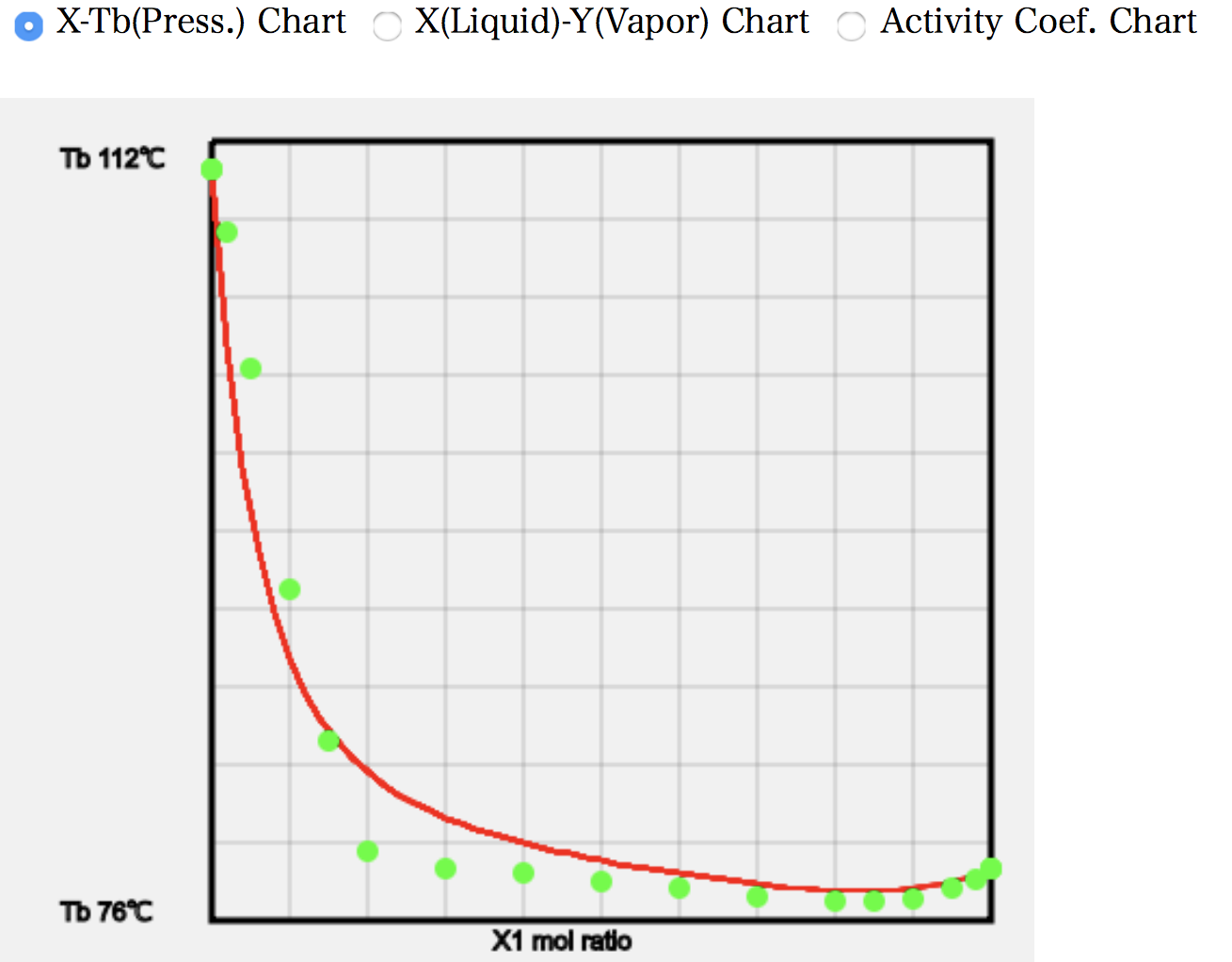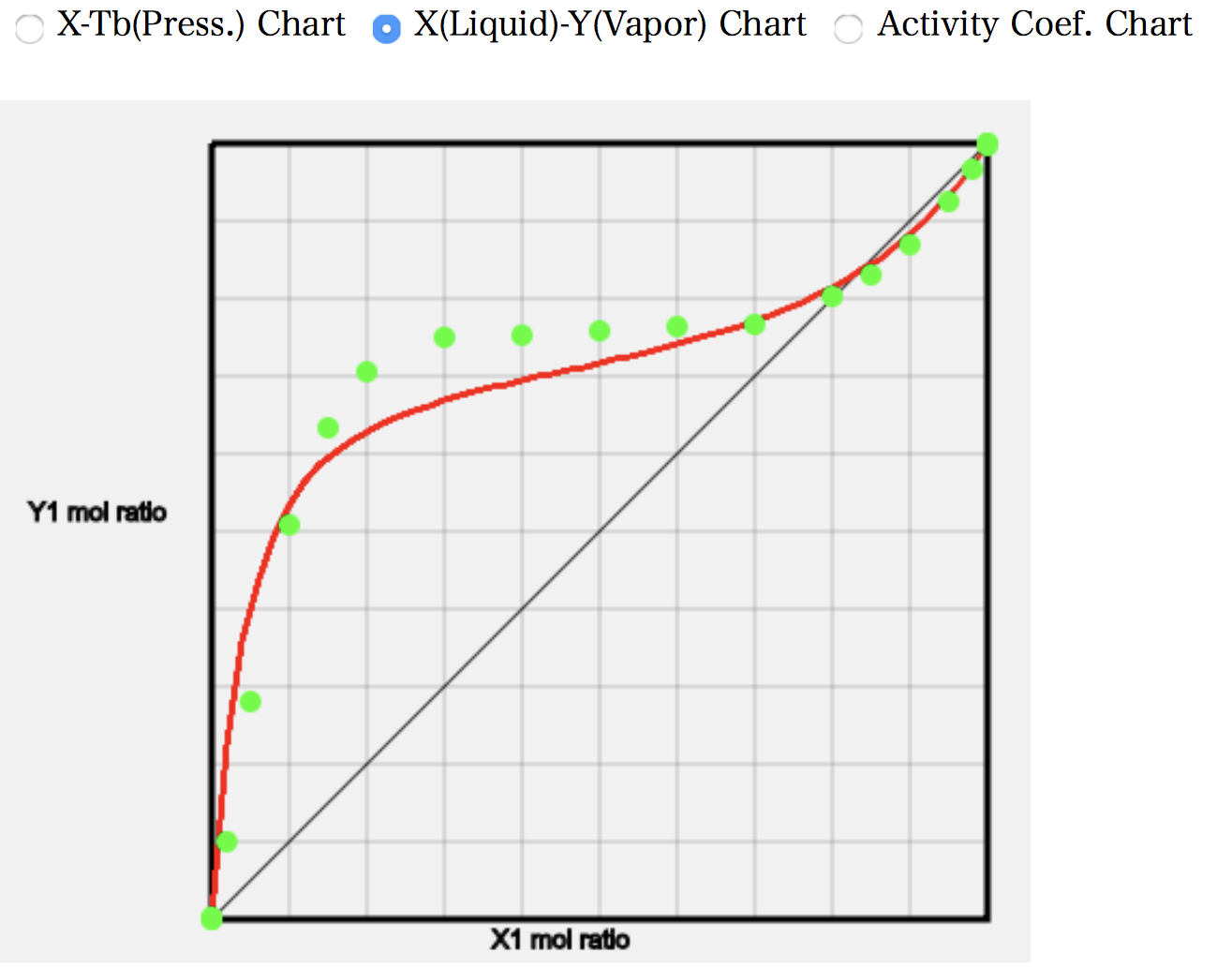2024.9.04
pirika.comで化学 > 化学全般 > 化学工学 > 復刻版:ASOGによる気液平衡推算法 > 第2章 ASOG法 > 2.3 実際のASOG法計算
2.3.4 ASOG法による共沸点の評価
書籍では,ASOG法で求めたアルコール類と炭化水素化合物の共沸点と、実測の共沸点の比較が記載されている。同じ溶媒ペアで,圧力一定でも圧力が異なるもの,温度一定でも温度が異なるものなどが多数記載されている。そこで実質的な溶媒ペアはとても限定されている。
アルコールとしては、C1からC4までの異性体を含む化合物が使われている。炭化水素としては、C1-C8までの、鎖状炭化水素、環状炭化水素、芳香族炭化水素が使われている。
これらの共沸点の組成と温度は書籍には記載されていないので、別途構築した、常圧の共沸点のデータベースの値を使うことにする。
例題として、(12)Ethanol/Tolueneを計算して見よう。プログラムでは、溶媒ペアを指定すると、データベースを検索する。その優先順位は、気液平衡の実測データベース、Wilsonパラメータのデータベース、そして共沸のデータベースの順になっている。従って気液平衡の実測データベースにその溶媒ペアが見つかった場合、実験値の緑色(水色)のデータ点は数多く表示される。


気相と液相の組成が一致する点は、DBの値は0.818だが、ASOGの推算値では0.832とよく一致している。

全ての結果をプロットすると、次のようになる。

共沸点の組成に関しては(7) heptane/1-Propanol以外、非常に良好な結果になっている。

共沸温度に関しては、ほぼ問題の無い結果になっている。
このようなことができると、どのように役に立つのか紹介しておこう。
例えば、(25) 2-Propanol/iso-Octaneを計算して見る。

この系については共沸点のデータしかない。そこで実測点は1つしかないが、実測値と推算値はよく一致しているのがわかる。
iso-Octaneはガソリンの主成分になる。ガソリンはエンジンルームに導入されて気化する。そして、プラグで着火されて燃えてその圧力でピストンを押す。その際に気化がどのように起こるかは重要な事になる。
最近、環境問題からガソリンにバイオ・エタノールを添加することがブラジルやアメリカでは多くなった。エタノールとiso-Octaneの気液平衡はどうなっているのか? それをコンピュータだけから予測することは非常に重要なことだ。
ガソリンは微量成分も含めると、約300種類の化合物の混合物だ。高機能ガソリンとして芳香族系の化合物が添加されることがある。ガソリンタンクの水抜き剤として2-Propanolが添加されることがある。2成分系を全て実測することは不可能だろう。ましてや多成分系になった場合には手もつけられなくなる。
なるべく精度の高い、しかも多成分に拡張可能なASOG法で活量係数を求めてしまうのは重要なことだ。
例題の中に、iso-Octaneの溶媒ペアを追加しておいた。ペアによっては、全く実測データはないが、試しに計算して見て欲しい。
(32) Methanol/iso-Octane
(33) Isobutanol /iso-Octane
(34) 1-Propanol/iso-Octane
(35) Ethanol/iso-Octane
日本では、エタノールは吸湿しやすく、錆が生じる事から、エタノールの代わりに、MTBEやETBEの使用が進んでいる。毒性の問題や製造コストの観点からものになるかはわからないが、これらの化合物の気液平衡の様子は確認しておくと良いだろう。
(36) Methyl tert-butyl ether (MTEB)/iso-Octane
(37) Ethyl tert-butyl ether (ETBE)/iso-Octane
(MTEBやETBEの共沸や気液平衡のデータをお持ちの方は是非連絡をいただければと思う。本書改訂の際には、反映させたいと思う。)
それ以外にも、電子基板の洗浄に、蒸気洗浄を使う場合、共沸混合物だと液相の組成と気相の組成が同じなのでコントロールしやすいなどのメリットがある。
臭素などの消火剤成分を加えた混合溶媒の場合にも、気相の引火性を抑える重要な考え方になる。
Copyright pirika.com since 1999-
Mail: yamahiroXpirika.com (Xを@に置き換えてください)
メールの件名は[pirika]で始めてください。
